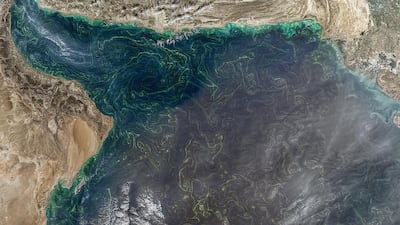Chemical imbalances in the Arabian Gulf caused by rapid warming and excessive use of fertiliser in agriculture could be expanding the world’s largest marine dead zone towards the UAE’s shores.
Researchers at New York University Abu Dhabi conducted a study that mapped the potential growth of the Arabian Sea’s dead zone - an area of low oxygen caused by excessive pollution that strains the resources needed to sustain marine life.
Dead zones are increasing in size and in number yearly because of rising water temperatures. Scientists are increasingly finding more aquatic systems succumbing to this man-made phenomena with a 2008 study counting more than 400 dead zones worldwide.
The research conducted in the Arabian Gulf adds to a growing body of global climate models that aim to better understand the effects of climate change on our oceans.
"Our study is the first to show that local temperature changes in a semi-enclosed sea, like the Arabian Gulf, can have important consequences for oxygen and marine habitats not only locally but also for ecosystems thousands of kilometres away," said Zouhair Lachkar, a senior scientist at NYUAD’s Center for Prototype Climate Modelling, who contributed to the study.
Dead zones are caused by an increase in nutrients, particularly nitrogen and phosphorus that are found in fertilisers, which leech into the water and prompt an algal bloom. As the algae decomposes, the bacteria that feeds on it consumes oxygen in the water, creating areas of low oxygen. The process can be exacerbated by warming seas and, with the Arabian Gulf predicted to grow warmer in the future, the dead zone could intensify.
Mr Lachkar, along with K Shafer Smith, professor of mathematics, atmosphere, and ocean science at NYUAD, and Marina Levy, deputy director at the Institute of Research for Development, used computer modelling and simulation to explore the dead zone.
Their results indicate that warming in the Gulf is resulting in depletion of oxygen and available nitrogen in the Arabian Sea. This can reduce marine habitats for species that cannot survive without adequate oxygen and may restrict the growth of phytoplankton, a kind of bacteria that serves as food for some animals in the North Indian Ocean.
"Our findings imply that temperature changes can lead to biases in global climate models at a scale much larger than the scale of the semi-enclosed seas themselves,” he said.
Humans can slow or halt the process of the ocean’s deoxygenation and the spread of the dead zone through reducing carbon dioxide emissions.


